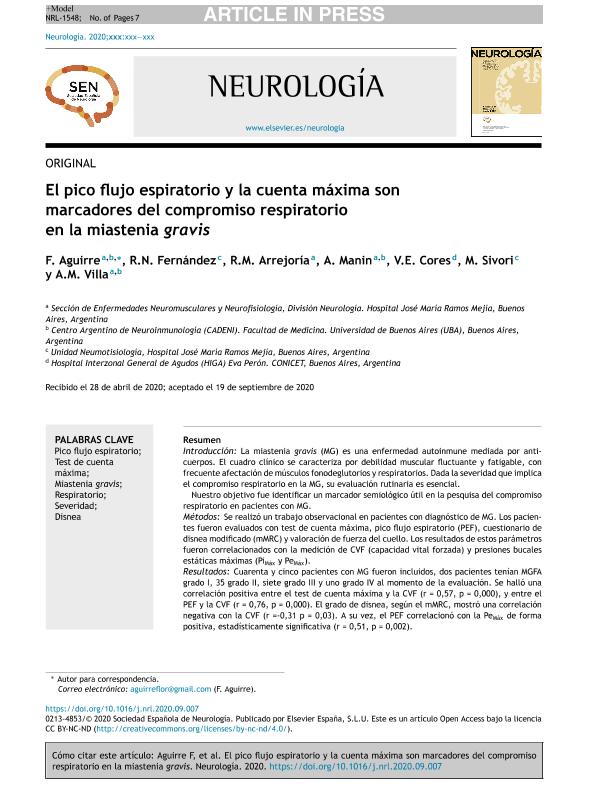Artículo
Introducción: La miastenia gravis (MG) es una enfermedad autoinmune mediada por anticuerpos. El cuadro clínico se caracteriza por debilidad muscular fluctuante y fatigable, con frecuente afectación de músculos fonodeglutorios y respiratorios. Dada la severidad que implica el compromiso respiratorio en la MG, su evaluación rutinaria es esencial. Nuestro objetivo fue identificar un marcador semiológico útil en la pesquisa del compromiso respiratorio en pacientes con MG. Métodos: Se realizó un trabajo observacional en pacientes con diagnóstico de MG. Los pacientes fueron evaluados con test de cuenta máxima, pico flujo espiratorio (PEF), cuestionario de disnea modificado (mMRC) y valoración de fuerza del cuello. Los resultados de estos parámetros fueron correlacionados con la medición de CVF (capacidad vital forzada) y presiones bucales estáticas máximas (PiMáx y PeMáx). Resultados: Cuarenta y cinco pacientes con MG fueron incluidos, dos pacientes tenían MGFA grado I, 35 grado II, siete grado III y uno grado IV al momento de la evaluación. Se halló una correlación positiva entre el test de cuenta máxima y la CVF (r = 0,57, p = 0,000), y entre el PEF y la CVF (r = 0,76, p = 0,000). El grado de disnea, según el mMRC, mostró una correlación negativa con la CVF (r =-0,31 p = 0,03). A su vez, el PEF correlacionó con la PeMáx de forma positiva, estadísticamente significativa (r = 0,51, p = 0,002). Conclusiones: El PEF, el test de cuenta máxima y el mMRC fueron útiles para evaluar la función respiratoria en pacientes con MG. Introduction: Myasthenia gravis (MG) is an antibody-mediated autoimmune disease characterised by fluctuating, fatigable muscle weakness, frequently involving bulbar and respiratory muscles. Considering the severity of respiratory involvement in MG, routine evaluation of respiratory function is essential. The aim of this study was to identify a useful clinical marker of respiratory involvement in patients with MG. Methods: We performed an observational study of patients with MG. All cases were evaluated with the single-breath counting test, peak expiratory flow (PEF), a modified Medical Research Council dyspnoea scale (mMRC), and a neck strength assessment. The results of these parameters were correlated with forced vital capacity (FVC), maximal inspiratory pressure (MIP), and maximal expiratory pressure (MEP). Results: The study included 45 patients with MG: 2 patients classified as grade I on the Myasthenia Gravis Foundation of America classification at the time of evaluation, 35 classified as grade II, 7 classified as grade III, and one classified as grade IV. Positive correlations were found between single-breath counting test scores and FVC values (r = 0.57, p = .000), and between PEF and FVC values (r = 0.76, p = .000). Severity of dyspnoea according to the mMRC scale showed a negative correlation with FVC values (r = -0.31, p = .03). PEF also showed a significant correlation with MEP (r = 0.51, p = .002). Conclusions: PEF, the single-breath counting test, and the mMRC scale are useful measures for evaluating respiratory function in patients with MG.
El pico flujo espiratorio y la cuenta máxima son marcadores del compromiso respiratorio en la miastenia gravis
Título:
Peak expiratory flow and the single-breath counting test as markers of respiratory function in patients with myasthenia gravis
Aguirre, Florencia; Fernández, Romina; Arrejoría, Rocio Mercedes; Manin, Analisa; Cores, Evangelina Valeria ; Sivori, Martín L.; Villa, Andres Maria
; Sivori, Martín L.; Villa, Andres Maria
 ; Sivori, Martín L.; Villa, Andres Maria
; Sivori, Martín L.; Villa, Andres Maria
Fecha de publicación:
12/2020
Editorial:
Elsevier
Revista:
Neurología - (Print)
ISSN:
0213-4853
e-ISSN:
1578-1968
Idioma:
Español
Tipo de recurso:
Artículo publicado
Clasificación temática:
Resumen
Archivos asociados
Licencia
Identificadores
Colecciones
Articulos(SEDE CENTRAL)
Articulos de SEDE CENTRAL
Articulos de SEDE CENTRAL
Citación
Aguirre, Florencia; Fernández, Romina; Arrejoría, Rocio Mercedes; Manin, Analisa; Cores, Evangelina Valeria; et al.; El pico flujo espiratorio y la cuenta máxima son marcadores del compromiso respiratorio en la miastenia gravis; Elsevier; Neurología - (Print); 2020; 12-2020; 1-7
Compartir
Altmétricas



